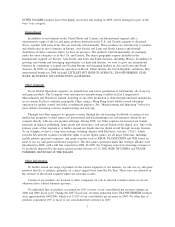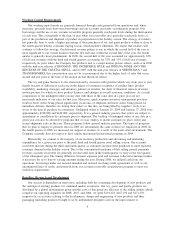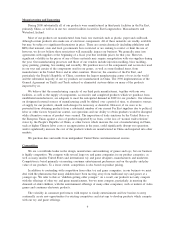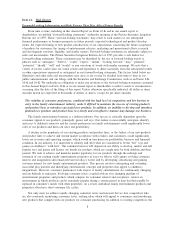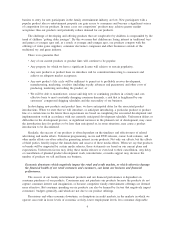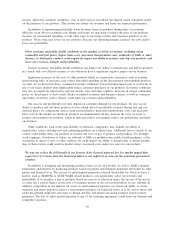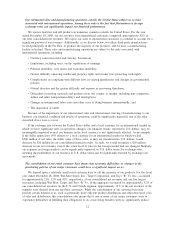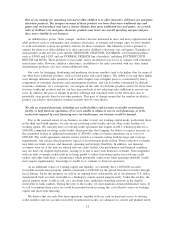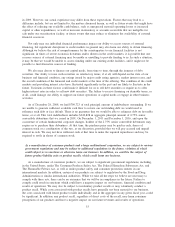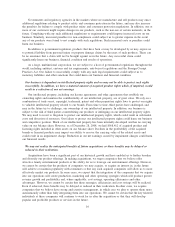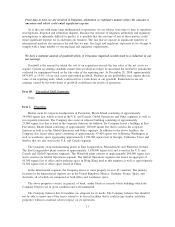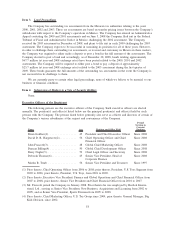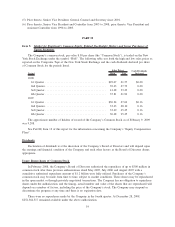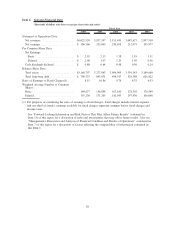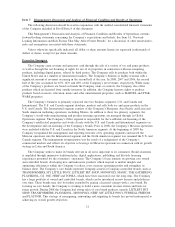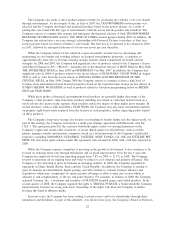Hasbro 2008 Annual Report Download - page 22
Download and view the complete annual report
Please find page 22 of the 2008 Hasbro annual report below. You can navigate through the pages in the report by either clicking on the pages listed below, or by using the keyword search tool below to find specific information within the annual report.Our substantial sales and manufacturing operations outside the United States subject us to risks
associated with international operations. Among these risks is the fact that fluctuations in foreign
exchange rates can significantly impact our financial performance.
We operate facilities and sell products in numerous countries outside the United States. For the year
ended December 28, 2008, our net revenues from international customers comprised approximately 42% of
our total consolidated net revenues. We expect our sales to international customers to continue to account for a
significant portion of our revenues. Additionally, as we discuss below, we utilize third-party manufacturers
located principally in the Far East, to produce the majority of our products, and we have a manufacturing
facility in Ireland. These sales and manufacturing operations are subject to the risks associated with
international operations, including:
• Currency conversion risks and currency fluctuations;
• Limitations, including taxes, on the repatriation of earnings;
• Political instability, civil unrest and economic instability;
• Greater difficulty enforcing intellectual property rights and weaker laws protecting such rights;
• Complications in complying with different laws in varying jurisdictions and changes in governmental
policies;
• Natural disasters and the greater difficulty and expense in recovering therefrom;
• Difficulties in moving materials and products from one country to another, including port congestion,
strikes and other transportation delays and interruptions;
• Changes in international labor costs and other costs of doing business internationally; and
• The imposition of tariffs.
Because of the importance of our international sales and international sourcing of manufacturing to our
business, our financial condition and results of operations could be significantly harmed if any of the risks
described above were to occur.
If the exchange rate between the United States dollar and a local currency for an international market in
which we have significant sales or operations changes, our financial results, reported in U.S. dollars, may be
meaningfully impacted even if our business in the local currency is not significantly affected. As an example,
if the dollar appreciates 10% relative to a local currency for an international market in which we had
$200 million of net sales, the dollar value of those sales, as they are translated into U.S. dollars, would
decrease by $20 million in our consolidated financial results. As such, we would recognize a $20 million
decrease in our net revenues, even if the actual level of sales in the foreign market had not changed. Similarly,
our expenses in foreign markets can be significantly impacted, in U.S. dollar terms, by exchange rates,
meaning the profitability of our business in U.S. dollar terms can be significantly harmed by exchange rate
movements.
The consolidation of our retail customer base means that economic difficulties or changes in the
purchasing policies of our major customers could have a significant impact on us.
We depend upon a relatively small retail customer base to sell the majority of our products. For the fiscal
year ended December 28, 2008, Wal-Mart Stores, Inc., Target Corporation, and Toys “R” Us, Inc., accounted
for approximately 25%, 12% and 10%, respectively, of our consolidated net revenues and our five largest
customers, including Wal-Mart, Target and Toys “R” Us, in the aggregate accounted for approximately 52% of
our consolidated net revenues. In the U.S. and Canada segment, approximately 71% of the net revenues of the
segment were derived from our top three customers. While the consolidation of our customer base may
provide certain benefits to us, such as potentially more efficient product distribution and other decreased costs
of sales and distribution, this consolidation also means that if one or more of our major customers were to
experience difficulties in fulfilling their obligations to us, cease doing business with us, significantly reduce
12



